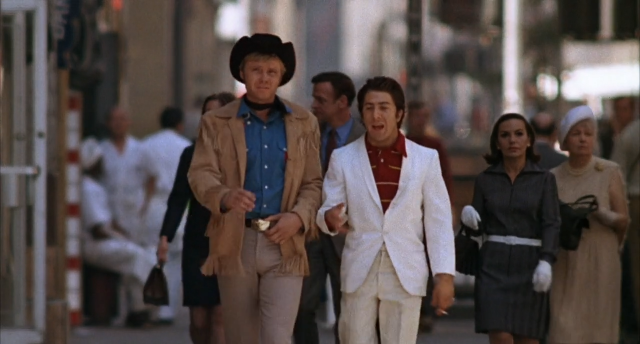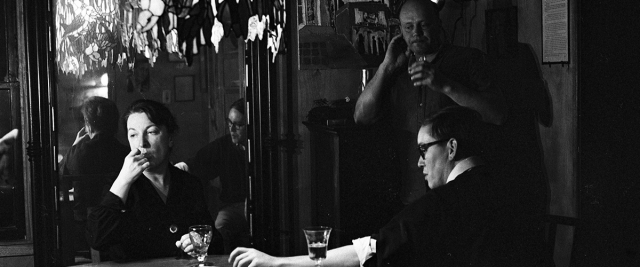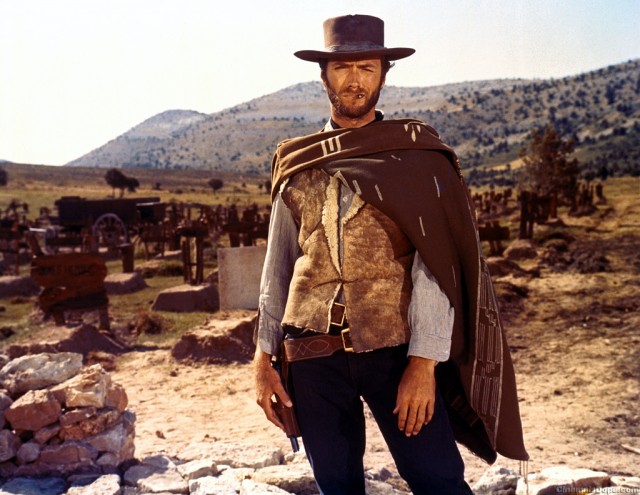
Oscar nominees Jon Voight and Dustin Hoffman try to make it in the big city in John Schlesinger’s powerful Midnight Cowboy
MIDNIGHT COWBOY (John Schlesinger, 1969)
DESPERATE SOULS, DARK CITY AND THE LEGEND OF MIDNIGHT COWBOY (Nancy Biurski, 2022)
Film Forum
209 West Houston St.
Opens Friday, July 7
212-727-8110
filmforum.org
The only X-rated film to win a Best Picture Oscar, John Schlesinger’s masterful Midnight Cowboy follows the exploits of Joe Buck (Jon Voight), a friendly sort of chap who leaves his small Texas town, determined to make it as a male prostitute in Manhattan. Wearing his cowboy gear and clutching his beloved transistor radio, he trolls the streets with little success. Things take a turn when he meets up with Enrico Salvatore “Ratso” Rizzo (Dustin Hoffman), an ill, hobbled con man living in a condemned building. The two loners soon develop an unusual relationship as Buck is haunted by nightmares, shown in black-and-white, about his childhood and a tragic event that happened to him and his girlfriend, Crazy Annie (Jennifer Salt), while Rizzo dreams of a beautiful life, depicted in bright color, without sickness or limps on the beach in Miami.
Adapted by Waldo Salt (Serpico, The Day of the Locust) from the novel by James Leo Herlihy, Midnight Cowboy is essentially a string of fascinating and revealing set pieces in which Buck encounters unusual characters as he tries desperately to succeed in the big city; along the way he beds an older, wealthy Park Ave. matron (Sylvia Miles), is asked to get down on his knees by a Bible thumper (John McGiver), gets propositioned in a movie theater by a nerdy college student (Bob Balaban), has a disagreement with a confused older man (Barnard Hughes), and attends a Warholian party (thrown by Viva and Gastone Rosilli and featuring Ultra Violet, Paul Jabara, International Velvet, Taylor Mead, and Paul Morrissey) where he hooks up with an adventurous socialite (Brenda Vaccaro).
Photographed by first-time cinematographer Adam Holender (The Panic in Needle Park, Blue in the Face), the film captures the seedy, lurid environment that was Times Square in the late 1960s; when Buck looks out his hotel window, he sees the flashing neon, with a sign for Mutual of New York front and center, the letters “MONY” bouncing across his face with promise. The film is anchored by Harry Nilsson’s Grammy-winning version of “Everybody’s Talkin’,” along with John Barry’s memorable theme. Iconic shots are littered throughout, along with such classic lines as “I’m walkin’ here!”
Midnight Cowboy, which was nominated for seven Oscars and won three (Best Picture, Best Adapted Screenplay, and Best Director), is screening at Film Forum in conjunction with the theatrical release of Nancy Buirski’s Desperate Souls, Dark City and the Legend of Midnight Cowboy, which is not a typical making-of documentary; inspired by Glenn Frankel’s 2021 book, Shooting Midnight Cowboy: Art, Sex, Loneliness, Liberation, and the Making of a Dark Classic, Buirski explores the social context in which Midnight Cowboy was created and brought to the public. The film opens with Voight telling a great story about the day shooting wrapped:
“That’s the last shot. . . . John [Schlesinger], he was like this, shaking. I said, ‘John, what’s the matter?’ He said, ‘What have we done? What have we done? We’ve made a movie about a dishwasher who goes and fucks a lot of women in New York. What’ll they say? What’ll they say about this picture?’ I said, and I knew he’s having a complete meltdown, right? I didn’t know what to do. I mean, I was his friend, I want to help him. I grabbed him by the shoulders and I said, ‘John,’ — I looked him in the eye — ‘we will live the rest of our artistic lives in the shadow of this great masterpiece.’ He looks up, ‘You think so?’ [Voight laughs] I said, ‘I’m absolutely certain of it.’ It was the only thing that could get him out of it. I said the most ridiculous thing I could think of but . . . turned out to be true.”
Buirski (The Loving Story, Afternoon of a Faun: Tanaquil Le Clercq) speaks with Jennifer Salt, the daughter of Waldo Salt, who played Crazy Annie; Bob Balaban, who portrayed the college student in the movie theater; Brenda Vaccaro, who plays the socialite; cultural critic Lucy Sante; Schlesinger’s nephew, author Ian Buruma; film critic James Hoberman; Charles Kaiser, author of The Gay Metropolis; photographer Michael Childers, Schlesinger’s longtime partner; and cinematographer Adam Holender, who contributes modern-day photos of New York City. Writer, director, and producer Buirski and editor Anthony Ripoli include a barrage of archival color and black-and-white footage of the Vietnam War, Times Square, the Chicago Seven, and the moon landing; clips from dozens and dozens of movies, from The Graduate, Easy Rider, The Sound of Music, Flaming Creatures, The Boys in the Band, Taxi Driver, and numerous Westerns and Andy Warhol works to such other Schlesinger films as A Kind of Loving, Billy Liar, Darling, and Sunday Bloody Sunday. There are also snippets of older interviews with Waldo Salt, James Leo Herlihy, and Dustin Hoffman; Voight’s original screen test with Salt; and home movies of Schlesinger, who died in 2003 at the age of seventy-seven.
Desperate Souls focuses on the changing postwar class system; homoeroticism, particularly as it relates to the macho image of cowboys, from John Wayne to the Marlboro Man; and the transformation of pop culture in the 1970s, with a soundtrack that includes songs by Don McLean, the Guess Who, Gerry & the Pacemakers, and Janis Ian. There’s a significant amount of information overload about the era and Midnight Cowboy’s legacy instead of more behind-the-scenes details, but you can find out more when Buirski and Holender take part in a Q&A following the 6:00 screening on July 7 at Film Forum.


 One of the all-time-great spaghetti Westerns, Sergio Leone’s dusty three-hour operatic oater stars Clint Eastwood as the Good (Blondie), Lee Van Cleef as the Bad (Angel Eyes), and Eli Wallach as the Ugly (Tuco Benedicto Pacifico Juan Maria Ramirez, whose list of criminal offenses is a riot), three unique individuals after $200,000 in Confederate gold buried in a cemetery in the middle of nowhere. Nearly 20 minutes of never-before-seen footage added to the film a few years ao, with Wallach and Eastwood overdubbing brand-new dialogue, so if you haven’t seen it in a while, it might just be time to catch it again, this time on the big screen as part of the Museum of the Moving Image’s “See It Big!” series. Ennio Morricone’s unforgettable score and Torino delli Colli’s gorgeous widescreen cinematography were also marvelously enhanced; their work in the scene when Tuco first comes upon the graveyard will make you dizzy with delight. And then comes one of the greatest finales in cinema history. The Good, the Bad and the Ugly is screening at the museum on February 10 at 7:00, with the series continuing with such classics as Samuel Fuller’s Forty Guns on February 19 (introduced by Dan Callahan), The Sound of Music on March 3, North by Northwest on March 9-10, Andrei Tarkovsky’s The Mirror on March 11 (introduced by Geoff Dyer), and Touch of Evil on March 16-17.
One of the all-time-great spaghetti Westerns, Sergio Leone’s dusty three-hour operatic oater stars Clint Eastwood as the Good (Blondie), Lee Van Cleef as the Bad (Angel Eyes), and Eli Wallach as the Ugly (Tuco Benedicto Pacifico Juan Maria Ramirez, whose list of criminal offenses is a riot), three unique individuals after $200,000 in Confederate gold buried in a cemetery in the middle of nowhere. Nearly 20 minutes of never-before-seen footage added to the film a few years ao, with Wallach and Eastwood overdubbing brand-new dialogue, so if you haven’t seen it in a while, it might just be time to catch it again, this time on the big screen as part of the Museum of the Moving Image’s “See It Big!” series. Ennio Morricone’s unforgettable score and Torino delli Colli’s gorgeous widescreen cinematography were also marvelously enhanced; their work in the scene when Tuco first comes upon the graveyard will make you dizzy with delight. And then comes one of the greatest finales in cinema history. The Good, the Bad and the Ugly is screening at the museum on February 10 at 7:00, with the series continuing with such classics as Samuel Fuller’s Forty Guns on February 19 (introduced by Dan Callahan), The Sound of Music on March 3, North by Northwest on March 9-10, Andrei Tarkovsky’s The Mirror on March 11 (introduced by Geoff Dyer), and Touch of Evil on March 16-17.